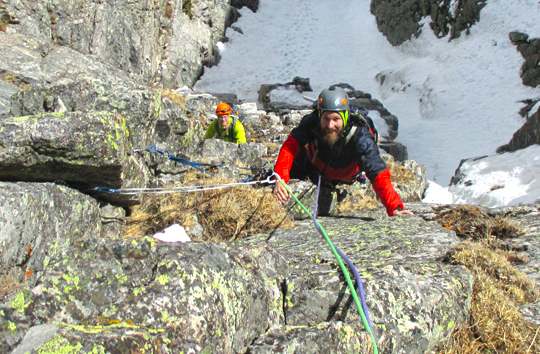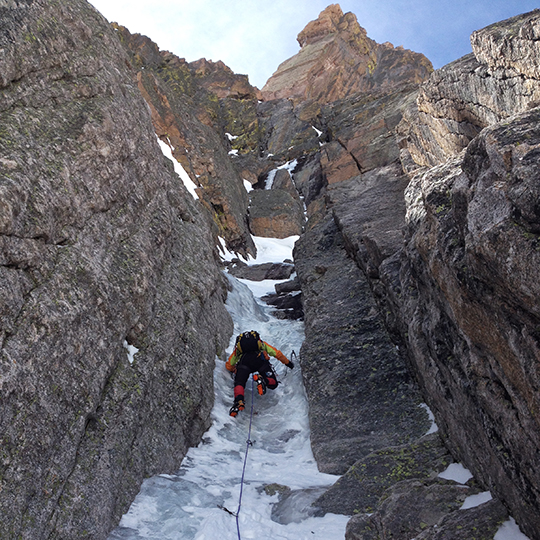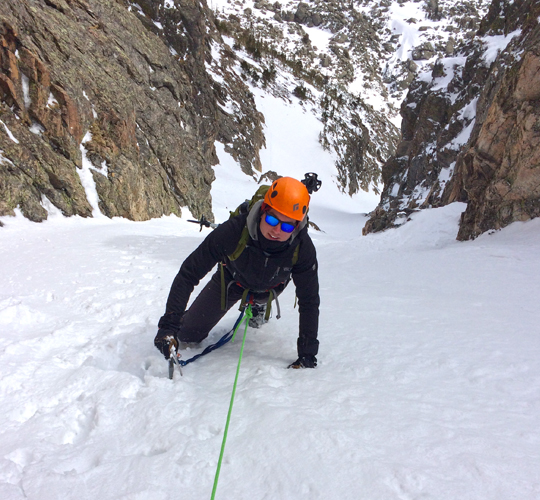[Photo] Mike Lewis
MSRP: $239.95 (60m) $269.95 (70m) $299.95 (80m)
I bought my first rope in 1993–an 11mm workhorse that acted as both my lead and, later, as a haul line on Yosemite’s big walls. As the 90s came to a close, I focused on harder free climbing and downsized to a 9.8mm. At the time, a 9.8mm was considered very skinny, and other climbers sometimes questioned the safety of the line as I took repeated, big falls on it.
Today, fifteen years later, I still push my limits when climbing, but I’m also a guide, and I view ropes as the safety line for my clients, more so than just for personal climbing. Although rope technology has greatly improved in the twenty-some years since I started climbing, I was still skeptical when a lime-green Mammut 8.7mm Serenity rope showed up on my doorstep. (The Serenity is also available in ocean blue.) The manufacturer states this rope is designed for single, double and twin configurations. Mammut also says the rope is designed to stretch 31 percent when arresting a fall. When used as a single, the Serenity is the thinnest-diameter cord in Mammut’s line.
Right away I was impressed with the rope’s low weight and low bulk, but I wanted to know how it would hold up to day-after-day guiding and AMGA crevasse rescue drills.
For the following five months, I used the rope in Colorado’s Rocky Mountain National Park (RMNP) and in Washington’s North Cascades. Additionally, I tested it in Alaska on steep snow climbs, on low-angled multi-pitch rock routes, and technical mixed alpine routes, ski mountaineering, and glacier travel.

[Photo] Mike Lewis
Recently I guided two clients on Hallett Chimney in RMNP–an all-day climb rated AI5 M5 that tops out at 12,713 feet. I used the new rope and one from my collection as singles; so each client was tied to one rope.
The clients wanted to know the differences between a rope that is designed to be used as a single, double and twin. I explained that a double means that the leader only clips one rope at a time, in succession, to each protection point. Twin ropes are used together (in tandem), and the leader clips both ropes into each piece of protection.
Mammut states the Serenity weighs 51 grams per meter. In comparison, the Edelrid Swift Pro Dry 8.9mm and the Sterling Fusion Nano IX 9.0mm both weigh 52 grams per meter. This is a difference of merely 0.13 pounds (2.1 ounces) and is hardly noticeable.
Though the weight savings between the 8.7 Serenity and Swift Pro Dry and Fusion Nano are minimal, one thing is true: obviously the ropes pack down and weigh less than 9.2-9.4mm ones. The space and reduced weight means having a tighter, lighter and more easily balanced pack to carry on long approaches.

[Photo] Mike Lewis
In addition, the Serenity handles well and has a long-lasting dry coating. For example, when I handled the rope (or ropes) in auto-block mode in the DMM Pivot and the Black Diamond ATC Guide, I found it ran smoothly, yet still arrested falls without slipping–these are big pluses. The low friction means that my elbows get a break–after all, guiding requires a lot of belaying, and this repetitive stress builds up.
When I used the ropes on an AMGA crevasse rescue drill, they performed exceptionally well. Some of the other guides experienced slippage between the sheath and core on their ropes, when handling friction hitches. But I didn’t have that problem with the Serenities.
Also of note is the dry sheath and core coating that Mammut uses. This application is both a heat process and a coating finish. The company’s treatment is compliant with UIAA Dry Standards, which require that dry-treated ropes only absorb less than 5 percent of their weight in water. The Serenities absorb up to 1.5 percent of their weight in water.
Today, after I’ve tested the ropes over about 50 guide days and personal days on rock, snow and ice, they’re are still in great shape, and I plan to continue climbing with them for some time.
Regarding drawbacks: the Serenity is not available in bi-color. Although the rope does have black middle marks on either side of the center, these marks faded quickly. Searching for the faded middle mark costs time and requires extra attention; especially when I’m trying to keep the ropes organized at belay stations.

[Photo] Mike Lewis
Another drawback–and one I’ve experienced with the numerous Mammut ropes–is that the Serenity is stiff and has a cable-like feel. This stiffness means I have to spend more time dressing knots so they don’t loosen over time. I found the stiff Serenity was more difficult to manage when I used a Munter hitch than other, suppler ropes are. Even after extended use, the Serenity continued to maintain its stiffness; other ropes would break in.
My final critique is more of a warning. Though it’s true that the Serenity is applicable for all types of climbing, I still consider it a specialty cord. (Mammut states the Serenity is ideal for sport climbing, alpine climbing, comp climbing, mixed and ice climbing and multipitch climbing.) I wouldn’t want to fall on it, on lead or when following, on Eldo’s rough, sharp sandstone. The thought of the slinky line rolling over sharp edges and through loose rock gives me an uneasy feeling. For hard adventure climbing on loose terrain, I’ll stick to a thicker cord every time, even if just for the piece of mind.
Pros: Single-rated sub-9mm diameter; lightweight; durable
Cons: Not available in bi-pattern; stiff, making it harder to coil than supple ropes; knots require additional dressing; too skinny for my taste to use for hard adventure climbing.
Mike Lewis, M.A. is an AMGA Certified Rock and Alpine Guide living in Estes Park, CO. Mike has been guiding and instructing for 22 years throughout the U.S. and internationally. Learn more about him at LunchboxJackson.com.